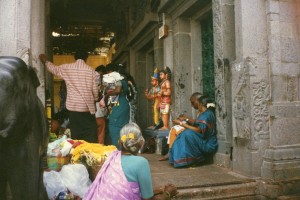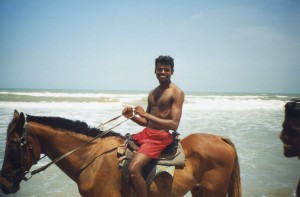Today we’ll proceed more deeply into one of the world’s most influential texts, the Rg Veda.
Many of the high flying philosophies in the Upanisads, and many of the epic visions in the Mahabharata and Ramayana emerged from this older text. Yet the Rg Veda is a dark continent for most people. We’ll find out what makes it special.
1. The Rg Veda is structured into 10 books, called mandalas. Mandalas II-VII are the oldest, and each is attributed to a different family of rishis, or sages.
2. The Rg Veda is sruti—hearing from the gods. Sruti is often distinguished from smrti, which is what’s remembered. Sruti comes from the deepest truths in the universe, and a rishi perceives it directly.
3. Mandalas II-VII contain hymns to gods that were performed at sacrifices. Fire was central in these rites. Gifts of food and drink were poured into the fire. The gods rested on sacred grass that was piled on sacrificial grounds. There were often three fires, representing the heavens, earth, and the middle region in the atmosphere (called antariksha, and perhaps corresponding with ancient Greek aer). The grass was put between the fires as a seat for the distinguished guests.
4. People performed many sacrifices regularly. The agnihotra was done every morning and evening, and milk was the gift. There were new and full moon sacrifices, and offerings at the beginnings of spring, the monsoon and autumn. There were also animal sacrifices, and the horse sacrifice was the most elaborate. The king or tribal chief was honored in it. Not surprisingly, this was a dramatic shindig, with an elaborate procedure and lots of people playing dress-up. The Khmers who built Angkor Wat would have loved it.
How is the Rg Veda unique, and how has it been so influential in world cultural history?
1. Its society didn’t build temples. Rites were outdoors, where the offerings could be burned and transformed to smoke that would reach the gods. Egyptians, Greeks and Mesopotamians created monumental temples, and they were central in their cities. Ancient Indians could set up sacrificial grounds anywhere. Any place could be made sacred, and religion wasn’t bound to specific places.
2. Its people didn’t make statues–at least we don’t have evidence that they did. This is another dramatic contrast with Egypt, Greece and Mesopotamia. The latter three liked to visualize their gods in human forms, and set them up in places that resembled great houses (Pharaoh comes from per aa, great house). Mimesis (the imitation of what we see in the world as the basis of art and language) has been central in the West. But Vedic religion was portable and its locus of operation ranged far beyond any temple or image in human forms.
It needed to be portable for the nomadic animal herders roving over Central Asia and into India.
3. Over time, a tradition developed of seeing gods, not as buffed up copies of humans, but as impersonal energies that range across the universe. A rishi can internalize them and use them for the benefit of the community. This conviction might have been a seedbed for the later development of yoga.
4. The Rg Veda’s language is very dense. It didn’t describe things, as Greece’s Homer and Hesiod did. Homer described the gods so vividly that they seem like people. Watch out for flying dishes when you read about their feast. The Rg Veda’s language was performed in rituals, and it was supposed to embody the power that the universe came from.
The Vedic god of fire is Agni, and this word is related to ignite. The Rg Veda doesn’t describe what Agni looked like in detail, but it expresses many nuances in the meanings of his name. They relate to energy that transforms things into other states that are more spiritual. Agni is so dense with meanings that it embodies this very energy. So to properly chant the Vedas is not to describe things, but to imbibe the universe’s vibrations and use them for the rituals’ sponsors.
Most mainstream Western thought patterns coalesced around limits–around images, human-like figures, proportions, the agora, and the temple as a compartmentalized place. But in India, many currents were converging to encourage people to think that vastness is most basic. Two great cultures, two very creative ways of seeing reality. Each lens seems basic and self-evident to millions of people. But if you can look through the other lens, you can really fly through a vast universe. We’ll soar more in the next post.



{ 6 comments }
The epics such as Mahabharata and Ramayana are several times bigger than the Bible or the Illiad and the Odyssey combined.
A lot of things grow larger than life in India.
Can you recommend me an India trip? The wnsaer to this is simple: anything on this website is our recommendation, they’ve all been checked out, reviewed thoroughly and have theindiaphile seal of approval. This is based on customer service, respect for local culture, sustainable travel principles, sheer inventiveness, authenticity, courtesy and many other factors.
It would be great if you go to the north and south. Start in Delhi, and go to Mathura, Agra, Fatehpur Sikri and Benares–you’ll see some of the most famous images of India–stay at the Taj Mahal until closing time because you’ll never forget the experience of seeing it at night. But there have been many Iranian fusions in the north. If you go south afterwards, you’ll be more immersed in traditional Hindu culture. Tamil Nadu is the place to start–at least Tamils think so! But they have good reasons for it. You can base yourself in Chennai and take day trips to Mahamallapuram, Kanchipuram and Tirupati. If you have more time, you can take the train down to Madurai, which also has a lot of history, and a fantastic temple the size of a city block. Karnataka is great too. Bangalore is its biggest city–you can see how modern high tech industries mesh with traditioan Indian life. You can then take the bus to Mysore. There’s lots of history there, and a great Hoysala temple at Somnathpur that’s close. This is just one possible schedule, but it will give you an overview of the varieties of cultures in India.
We need to understand the Bhagvadgita to find the various moods of Shri Krishna during the Mahabharata war.
Understanding Krishna’s moods is a tough order. When he gave Arjuna a vision of the entire universe, Arjuna said he couldn’t handle it–it’s too intense, Krishna said that the best way to approach him is through love, but it’s like a moth flying into a candle and being consumed by the light. I think I’ll hang around with ordinary folks for a while:-)
Comments on this entry are closed.